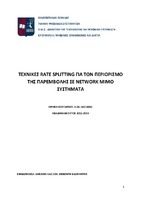Τεχνικές rate splitting για τον περιορισμό της παρεμβολής σε network MIMO συστήματα

View/
Abstract
Single frequency reuse is widely used in current state-of-the-art wireless systems, such as Long Term Evolution Advanced (LTE-A) [1], to deal with the increasing average cell throughput without bandwidth expansion. However, if interference mitigation techniques are absent in these systems, the cell-edge user equipments (UEs) will suffer from strong interference from adjacent cells which degrades the UE throughput. In order to improve the average cell throughput as well as the cell-edge UE throughput, a powerful interference mitigation technique is an inevitable part of wireless systems. In this study, in chapter 2, the cooperation in a multicellular environment where base stations (BSs) wish to jointly serve multiple users, under a constrained-capacity backhaul is presented. For finite backhaul capacity a trade-off between sharing user data, which allows for full MIMO cooperation, and not doing so, which reduces the setup to an interference channel but also requires less overhead, emerges. Simulation results illustrate how the capacity of the backhaul determines how much of the user data is worth sharing across multiple BSs. In the following chapter, one user equipment pair selection algorithm and a cooperative proportional fair scheduling algorithm are presented. The coordinated multi-point transmission framework based on the cooperative rate splitting scheme is proposed in the Long Term Evolution Advanced system and can be considered to improve the cell-edge UE performance by decoding part of the interference. This work, as the most publications in this field, neglects the main downside of such systems, namely, the need for an additional network backhaul. To erase this downside a more realistic scheme is proposed in chapter 4 which is organized as follows. In Section I, the system model and proposed transmission scheme of the CoMP via Cooperative Rate Splitting and Scheduling scheme under backhaul restriction, are presented. In Section II, the five cases achievable rate regions are introduced. The study is completed with a presentation and discussion of simulation results in Section III. Finally, some conclusions are presented in chapter 5.


